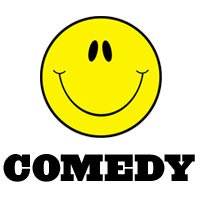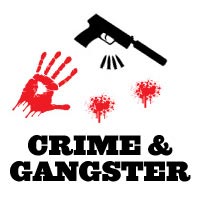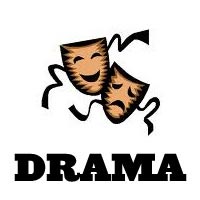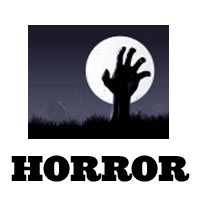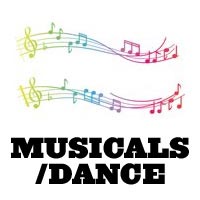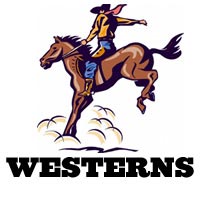Components
of Film Genres
|
1. The creation of a characteristic SETTING or PERIOD with
various stereotypes, props, or icons
- modern day
- specific decade or year
- historical or fictional
- urban/rural, etc.
|
 Horror: Dark
and isolated foreboding places and unexplained things,
located in forests or woods, out-of-the-way camp grounds
or areas (off the beaten path), graveyards or cemeteries,
basements, attics, spooky castles, haunted houses, abandoned
buildings or structures, locked doors to remote rooms Horror: Dark
and isolated foreboding places and unexplained things,
located in forests or woods, out-of-the-way camp grounds
or areas (off the beaten path), graveyards or cemeteries,
basements, attics, spooky castles, haunted houses, abandoned
buildings or structures, locked doors to remote rooms |
 Sci-Fi: Outer
space, in a planetary system or on a planet, or in the
future or parallel universe or dimension, or in a virtual
world, or during time travel, with laser blasters and
spaceships, aliens, etc. Sci-Fi: Outer
space, in a planetary system or on a planet, or in the
future or parallel universe or dimension, or in a virtual
world, or during time travel, with laser blasters and
spaceships, aliens, etc. |
 Sports: Sports
arenas or other venues (track, football baseball or soccer
field, boxing ring, race track, basketball or tennis
courts, etc.), with teams, athletes, referees, judges,
coaches and competition or combat displaying physical
skill or endurance, crowds and audiences and fans Sports: Sports
arenas or other venues (track, football baseball or soccer
field, boxing ring, race track, basketball or tennis
courts, etc.), with teams, athletes, referees, judges,
coaches and competition or combat displaying physical
skill or endurance, crowds and audiences and fans |
 War: battlefields
or war zones, with bomber planes and tanks, involved
in naval, air, or land battles; spy activities, also
includes scenes with soldiers either at war or on the
homefront, or in basic training (preparation for fighting),
or POW camps War: battlefields
or war zones, with bomber planes and tanks, involved
in naval, air, or land battles; spy activities, also
includes scenes with soldiers either at war or on the
homefront, or in basic training (preparation for fighting),
or POW camps |
 Westerns: on
the frontier, small towns, ranches, during cattle-drives,
in Native-American villages, with stagecoaches, saloons,
horses, six-shooters or revolvers, rifles, Stetson hats,
bandannas, spurs, and buckskins, and ten-gallon hats Westerns: on
the frontier, small towns, ranches, during cattle-drives,
in Native-American villages, with stagecoaches, saloons,
horses, six-shooters or revolvers, rifles, Stetson hats,
bandannas, spurs, and buckskins, and ten-gallon hats |
|
2. The use of CHARACTERS (or
stock characterizations)
|
 Comedy: the
nerd, the wise-cracker, the jock, geek, or token minority,
buddies, gay best friend Comedy: the
nerd, the wise-cracker, the jock, geek, or token minority,
buddies, gay best friend |
 Crime: the
hard-boiled detective or private eye, police officer,
gangsters, hoodlums, criminals, robbers, murderers, a
mob boss, inmates, fugitives, a gun-for-hire, jewel robbers,
arms or drug dealers, car thieves, con artists, unforgettable
villain(s) Crime: the
hard-boiled detective or private eye, police officer,
gangsters, hoodlums, criminals, robbers, murderers, a
mob boss, inmates, fugitives, a gun-for-hire, jewel robbers,
arms or drug dealers, car thieves, con artists, unforgettable
villain(s) |
 Horror: zombies,
werewolves, vampires, ghosts or serial killers, slashers,
witches, predators, mad scientists, demons, shape-shifters,
monstrous or giant creatures, supernatural forces, large
numbers or masses of something dangerous (or harmless) Horror: zombies,
werewolves, vampires, ghosts or serial killers, slashers,
witches, predators, mad scientists, demons, shape-shifters,
monstrous or giant creatures, supernatural forces, large
numbers or masses of something dangerous (or harmless) |
 Sci-Fi: aliens
or monsters/killers, space or time travelers (astronauts,
starship pilots, explorers, etc.), superheroes, mutants,
robots (cyborgs, androids, bionic humans, humanoids,
etc.), space pirates, clones or replicants Sci-Fi: aliens
or monsters/killers, space or time travelers (astronauts,
starship pilots, explorers, etc.), superheroes, mutants,
robots (cyborgs, androids, bionic humans, humanoids,
etc.), space pirates, clones or replicants |
 Sports: the
underdog, athletes, superstars, the jock vs. the brain,
the coach, the team, reenactments or docu-dramas of
real-life sports figures or events (or of fictional ones) Sports: the
underdog, athletes, superstars, the jock vs. the brain,
the coach, the team, reenactments or docu-dramas of
real-life sports figures or events (or of fictional ones) |
 Westerns: outlaws
and cowboys, drifters, rustlers, a cattle ranch empire
or RR baron-owner, the cavalry, homesteaders, bounty
hunters, the Marshal or Sheriff, stereotypical 'heroic
saviors' or 'good guys', saloon characters Westerns: outlaws
and cowboys, drifters, rustlers, a cattle ranch empire
or RR baron-owner, the cavalry, homesteaders, bounty
hunters, the Marshal or Sheriff, stereotypical 'heroic
saviors' or 'good guys', saloon characters |
|
3. The use of REPRESENTATIVE CONTENT and SUBJECT
MATTER (the storyline,
themes, narrative or plot) resonant with other films in the genre
category
|
 Action: the chase
or pursuit sequence or extended fight scene (sometimes
in slo-mo), gun violence, race against time, various
life-threatening situations, a mad killer on the loose,
a bigger-than-life brawny and/or heroic action character,
high body counts, display of martial arts, extensive
stunts, mindless violence (secondary character development)
and use of CGI Action: the chase
or pursuit sequence or extended fight scene (sometimes
in slo-mo), gun violence, race against time, various
life-threatening situations, a mad killer on the loose,
a bigger-than-life brawny and/or heroic action character,
high body counts, display of martial arts, extensive
stunts, mindless violence (secondary character development)
and use of CGI |
 Comedy: witty
dialogue, spoofs, parodies (i.e. Mel Brooks, Airplane!
(1980), the Scream trilogy), gross-out humor and slapstick
(pratfalls, sight-gags), clownish comedies with central
comic figure(s) (Marx Bros., Chaplin, Laurel & Hardy,
Mae West, Martin & Lewis, Bob Hope, Harold Lloyd, Danny
Kaye, Robin Williams, Woody Allen, Will Ferrell, Pee-Wee
Herman, Eddie Murphy, etc.), rites of passage, fish-out-of-water,
mistaken identity, traditional dating rituals (will he/she
or won't he/she?), cross-dressing, 'screwball' comedies,
romantic comedies, sex comedies, black comedies (absurdist
situations) Comedy: witty
dialogue, spoofs, parodies (i.e. Mel Brooks, Airplane!
(1980), the Scream trilogy), gross-out humor and slapstick
(pratfalls, sight-gags), clownish comedies with central
comic figure(s) (Marx Bros., Chaplin, Laurel & Hardy,
Mae West, Martin & Lewis, Bob Hope, Harold Lloyd, Danny
Kaye, Robin Williams, Woody Allen, Will Ferrell, Pee-Wee
Herman, Eddie Murphy, etc.), rites of passage, fish-out-of-water,
mistaken identity, traditional dating rituals (will he/she
or won't he/she?), cross-dressing, 'screwball' comedies,
romantic comedies, sex comedies, black comedies (absurdist
situations) |
 Crime: who-dun-its,
heists or capers, robberies, rival gangs, police procedurals,
the FBI, an avenging detective, arch-villains, organized
crime and criminal syndicates, gangster and mob family
tales, hit-men, gang-race warfare, bootlegging, counter-cultural
heroes, tension
with a ticking clock, real-life criminal portraits, violence
and nihilism Crime: who-dun-its,
heists or capers, robberies, rival gangs, police procedurals,
the FBI, an avenging detective, arch-villains, organized
crime and criminal syndicates, gangster and mob family
tales, hit-men, gang-race warfare, bootlegging, counter-cultural
heroes, tension
with a ticking clock, real-life criminal portraits, violence
and nihilism |
 Horror:
fear inducing situations, the
'final girl' survivor, urban legends, ghost stories,
the mysterious and unknown, revenge beyond the grave,
the paranormal and occult, bloody gore and torture
with killing instruments, survival-horror, possessions,
exorcism, "found-footage"
tales, body violations, death during sex, horror in abandoned
or run-down places, buried alive, serial killings, good
vs. evil, psychological terror Horror:
fear inducing situations, the
'final girl' survivor, urban legends, ghost stories,
the mysterious and unknown, revenge beyond the grave,
the paranormal and occult, bloody gore and torture
with killing instruments, survival-horror, possessions,
exorcism, "found-footage"
tales, body violations, death during sex, horror in abandoned
or run-down places, buried alive, serial killings, good
vs. evil, psychological terror |
 Melodramas: the
self-sacrificial maternal figure, family crises, suffering,
emotional conflict, terminal illness or death, loss,
broken or failed relationships, overwrought emotions,
tragedy, unrequited love, toxic friendships Melodramas: the
self-sacrificial maternal figure, family crises, suffering,
emotional conflict, terminal illness or death, loss,
broken or failed relationships, overwrought emotions,
tragedy, unrequited love, toxic friendships |
 Musicals: singing
(solos, duets, choruses, ensembles) and dancing, 'putting
on a show', spectacular stage productions with beautiful
costuming, orchestra or band accompaniment, often with
a romantic subplot Musicals: singing
(solos, duets, choruses, ensembles) and dancing, 'putting
on a show', spectacular stage productions with beautiful
costuming, orchestra or band accompaniment, often with
a romantic subplot |
 Romance: stages
of courtship, 'falling in love' and the subsequent break-up
and reconciliation, forbidden love, searching for love,
Cyrano tales, sacrificial love, true love, fairy tales,
love at 'first sight', love triangles, "weepies", unconditional
love, escapist dramas, romantic comedies (identity switches) Romance: stages
of courtship, 'falling in love' and the subsequent break-up
and reconciliation, forbidden love, searching for love,
Cyrano tales, sacrificial love, true love, fairy tales,
love at 'first sight', love triangles, "weepies", unconditional
love, escapist dramas, romantic comedies (identity switches) |
 Sci-Fi: interstellar
travel, 'space operas', doomsday and apocalyptic scenarios
after an eco- or nuclear disaster, invasion of Earth
by hostile aliens (or other creatures), extensive visual
effects Sci-Fi: interstellar
travel, 'space operas', doomsday and apocalyptic scenarios
after an eco- or nuclear disaster, invasion of Earth
by hostile aliens (or other creatures), extensive visual
effects |
 War:
combat or war scenarios, including actual battle
conflict or traing and preparation for war between
nations or factions; also POW situations, spy or Resistance
fighter activities, veterans vs. rookies, tight-knit
teams or groups of soldiers, conflict against incredible
odds, PTSD, fight or flight scenarios, generals in
war rooms or on battlefield, men on a heroic mission,
victory or defeat War:
combat or war scenarios, including actual battle
conflict or traing and preparation for war between
nations or factions; also POW situations, spy or Resistance
fighter activities, veterans vs. rookies, tight-knit
teams or groups of soldiers, conflict against incredible
odds, PTSD, fight or flight scenarios, generals in
war rooms or on battlefield, men on a heroic mission,
victory or defeat |
 Westerns: conflicts
between native Americans and frontier encroachments or
US cavalry, hero (white hat) vs. villains or outlaws
(black hat) plots, 'spaghetti' westerns; 'revisionist'
westerns, B-westerns, musical and comedy westerns, cattle
drives Westerns: conflicts
between native Americans and frontier encroachments or
US cavalry, hero (white hat) vs. villains or outlaws
(black hat) plots, 'spaghetti' westerns; 'revisionist'
westerns, B-westerns, musical and comedy westerns, cattle
drives |
|
4. The use of FILMING TECHNIQUES AND FORMATS
|
- camera angles (use of low and high
angles) and shooting style (hand-held or stationary,
POV, or 'found footage')
- lighting (high-key, or low/dark lighting)
- the style of editing (length of edits,
use of jump cuts)
- color schemes
- make-up and costuming (use of blood,
masks, special effects)
|
|
5. The use of MUSIC AND AUDIO
- to enhance or emphasize
various characteristics
- to advance the plot
- to create a mood or atmosphere
(danger, adventure, laughter, fear, sensual, excitement)
|
- Romance or Comedy: upbeat
- Horror: foreboding, eerie
- Drama: depressing, dramatic
- Sci-Fi: other-worldly
|
|

![]()


